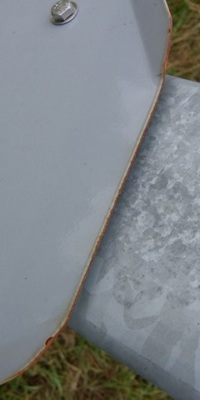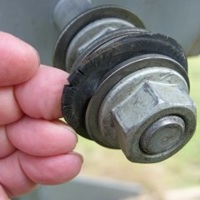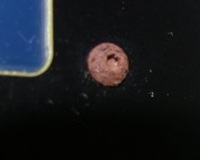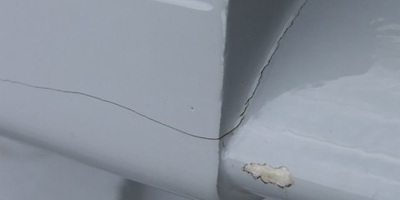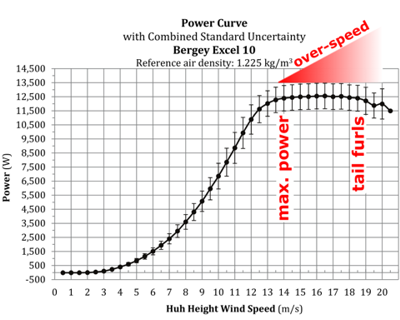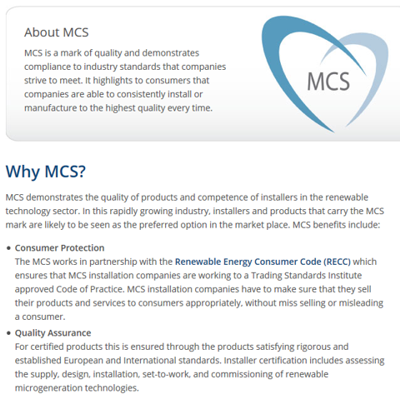Part 3: Summary - Good, Bad & Scandalous
Bergey Turbine – the GOOD:
- Very simple design, with little to go wrong, wear out or break.
- Extremely strong blades. The 'pultruding' process means there is a very high quantity of orientated glass fibre which makes the blades exceptionally robust.
Bergey Turbine – the BAD:
- The blades are fixed profile along their whole length, which is
less than optimal regarding energy capture and noise.
- Old technology inverter makes an annoying whistle while operating.
- Poor design / manufacture leaves a number of components not
fitting or deteriorating in just a few months, for example:
- tail-fin cut from pre-galvanised sheet but has no post-guillotine treatment so cut edges rust,
- nose cone (spinner) doesn't fit properly so packed out with a stack of washers,
- nose cone anti-vibration mounts made from UV susceptible material and cracked badly.
- inverter display screws have no corrosion protection so go rusty.
- Cracks between blade and mounting saddle. In itself this is not of structural significance BUT it allows water/ice into the blade root which could not be inspected. Any problem at the blade root would be masked - a worry considering how often the turbine 'over-speeds'.
None of the above is particularly difficult to put right, but it demonstrates a poor design attitude or bad quality control.
Bergey Turbine – the SCANDALOUS:
The UK Government issued a certificate under its MCS programme and promoted and encouraged people to install this wind turbine. The certificate includes a noise specification, but despite being installed correctly (and checked by NAPIT) at certain speeds the Bergey doesn't meet its specification by a huge margin! Further, just above the test range the turbine is deliberately allowed to over-speed and make even more noise.I believe these faults make this turbine unusable near habitation and brings the whole Government certification scheme into disrepute.
- Cogging from the alternator induced resonance resulting in a 'fog
horn' noise, 'warbles' and acoustic disturbance significantly outside
its MCS noise specification. Listen to resonance recordings from
Part 2:
- Gross over-speed. Once the inverter reaches maximum power the
turbine stays into the wind with no mechanical regulation. The turbine
then escapes to a very high speed with associated massive noise output.
The noise has been compared to a helicopter or turbo-prop aircraft.
This is a deliberate Bergey design decision; I assumes it is in
order to maximise yield, which could otherwise make the Bergey appear
uneconomic.
- The turbine is not permitted to be left in a 'braked' condition, so can not be legitimately stopped after installation.
Hutchinson's Tower – the GOOD:
- Light weight with relatively small foundation block means minimal
environmental impact.
- Easy to build and fairly low cost.
Hutchinson's Tower – the BAD:
- Structural resonance when used with Bergey turbine.
- Excessive deflection (too flexible) during gusty wind conditions.
However my own (very crude) test using a Telehandler to support the tower
suggests that it does meet the deflection/load requirements specified
by Bergey in their 'Manufacturer Tower Design Requirements' document.
This suggests that the problem is more likely to be excess load being
applied by the turbine.
- Weld distortion of flanges leaves a question as to the exact tension in the fixing bolts.
Micro-generation Certification Scheme (MCS)
In the next part of this write-up I attempt to go through the correct procedure and raise a complaint via MCS. After a year this eventually results in a meeting with representatives from MCS, BRE Global (the certification company) and DECC ('Department of Energy and Climate Change'). In summary: they appear desperate to avoid recognising this as a scheme problem.The screen dump opposite is how MCS markets itself, be warned it is just propaganda.
- "MCS is a mark of quality ..." ?
Based on my experience that seems difficult to justify in the everyday sense of the word.
- "... and demonstrates compliance to industry standards" ?
Are standards written by the industry itself what consumers or the wider public need? I suggest we need protection from unscrupulous manufactures and false or misleading claims?
- "Consumer Protection" ?
I am £50,000 out-of-pocket and the only suggestion from MCS was "sue your installer". Where is the protection?
- "without miss-selling or misleading" ?
I purchased on the basis of the MCS certificate, but even its very restricted data isn't remotely accurate. With prima facie evidence of a problem, MCS itself is misleading consumers and the public as it continues to certify and promote this turbine.
- "satisfying rigorous and established European and International
standards" ?
Purchasers of renewable energy systems and those who are affected by them (all ordinary citizens) rely on the Government to ensure these standards are appropriate - THEY ARE NOT!
- "competence of installers" ?
Does that include SIAC / Bergey who nearly toppled my tower?



